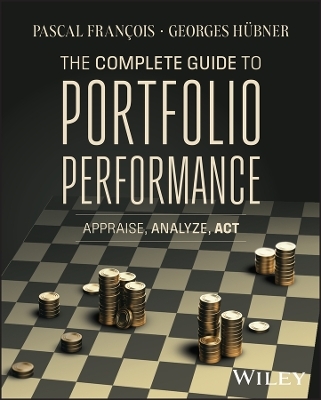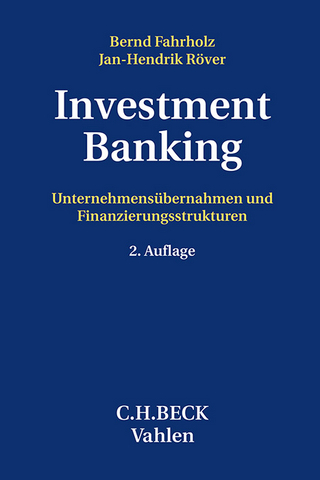
The Complete Guide to Portfolio Performance
John Wiley & Sons Inc (Verlag)
978-1-119-93017-4 (ISBN)
In The Complete Guide to Portfolio Performance: Appraise, Analyse, Act, a team of finance professors with extended practical experience deliver a hands-on desk reference for asset and wealth managers suitable for everyday use. Intuitively organized and full of concrete examples of the real-world implementation of the concepts discussed within, the book provides a comprehensive coverage of all important portfolio performance matters across 18 chapters of actionable and clearly described content. The authors have provided relevant cross-referencing where appropriate, “Key Takeaways and Equations” sections at the end of each chapter, and pointers to additional resources for anyone interested in pursuing further research.
You'll also find:
Discussions of more than a hundred classical and modern performance measures organized logically and with a focus on their applications
Strategies for selecting appropriate performance measures based on your situation as a manager or investor
Explanations of analytical techniques (statistical approaches, attribution, fund ratings...) enabling a comprehensive use of performance-related information
Applications of portfolio performance criteria in concrete investment decision-making processes
Highly actionable and logically organized material that's easy to find at a moment's notice
A full set of pedagogical powerpoint slides and excel worksheets with all data and formulas
Perfect for investors, portfolio managers, advisors, analysts, and regulators, The Complete Guide to Portfolio Performance is also a must-read reference for students and practitioners of asset and wealth management, as well as those pursuing certification such as CFA, CIPM, CIIA, and CAIA.
PASCAL FRANÇOIS is Professor of Finance at HEC Montréal. He is the founding director of the Canadian Derivatives Institute and a former co-editor of Finance, the academic journal of the French Finance Association. He holds a PhD from Sorbonne University and ESSEC. GEORGES HÜBNER is Professor of Finance at HEC Liège (Liège University, Belgium). Georges serves as a non-executive director at Belfius Bank and Belfius Asset Management, as well as an expert member of the investment committee of the CERN pension fund (Geneva). He is also the founder of two fintech companies, Gambit Financial Solutions and Sopiad. He holds a PhD from INSEAD.
Preface xxvii
Acknowledgements xxxi
About the Website xxxiii
Chapter 1 The Scope of Portfolio Performance 1
1.1 From Portfolio Management to Portfolio Performance 2
1.2 Rolling Out the Three Layers of Performance Evaluation 10
1.3 Returns, Risk, and Benchmarks 17
Key Takeaways and Equations 27
References 30
Part I Classical Performance Measurement 33
Chapter 2 Standard Portfolio Theory and the CAPM 35
2.1 The Portfolio Allocation Problem 37
2.2 The Market Portfolio and the Security Market Line 45
2.3 Implementing the CAPM 53
2.4 Multifactor Models 64
Key Takeaways and Equations 72
References 73
Chapter 3 Classical Portfolio Performance Measures 77
3.1 Peer Group Comparisons 80
3.2 The Sharpe Ratio 87
3.3 The Treynor Ratio, Jensen’s Alpha, and the Modified Jensen’s Alpha 100
3.4 The Information Ratio 114
Key Takeaways and Equations 126
References 129
Chapter 4 Selecting a Classical Performance Measure 131
4.1 Risk and Measurement Dimensions 134
4.2 Choosing a Measure for the Investor: The Normative Approach 140
4.3 Choosing a Measure for the Investor: The Positive Approach 154
4.4 Choosing a Measure for the Manager 167
Key Takeaways and Equations 177
References 180
Chapter 5 Pitfalls and Dangers with the Classical Performance Measures 183
5.1 Issues with the Standard Portfolio Theory Framework 185
5.2 Issues with the Capital Asset Pricing Model 197
5.3 Issues with the Sample 210
5.4 Issues with the Regressions 223
5.5 Issues with the Interpretations 233
Key Takeaways and Equations 247
References 250
Part II Developments in Performance Measurement 253
Chapter 6 The Classical Performance Measures Revisited 255
6.1 Refinements of the Sharpe Ratio 258
6.2 Alterations of the Sharpe Ratio 276
6.3 Alternative Versions of the other Classical Performance Measures 297
6.4 Classical Performance Measures as Risk-Adjusted Returns 305
Key Takeaways and Equations 318
References 321
Chapter 7 Performance Measurement in Multifactor Models 325
7.1 Types of Linear Multifactor Models 327
7.2 The Multifactor Alpha and the Multifactor Modified Alpha 345
7.3 Other Classical Performance Measures Adapted to Multifactor Models 357
7.4 Measuring Performance in Special Cases of Multifactor Models 364
Key Takeaways and Equations 373
References 376
Chapter 8 Performance Measurement with Market Timing 381
8.1 Piecewise-linear Regression Approach 385
8.2 Polynomial Regression Approach 400
8.3 Return-based Dynamic Exposures Approach 414
8.4 Holding-based Dynamic Exposures Approach 424
8.5 A Roadmap for Market Timing Performance Appraisal 434
Key Takeaways and Equations 440
References 443
Chapter 9 Preference-based Performance for the Standard Investor 447
9.1 The Structure of the Rational Investor’s Preferences 450
9.2 Preference-based Performance in the Standard Portfolio Theory 456
9.3 Performance Measurement with Standard Utility functions 468
Key Takeaways and Equations 481
References 484
Chapter 10 Preference-based Performance for the Behavioral Investor 487
10.1 The Structure of the Behavioral Investor’s Preferences 489
10.2 Performance Measurement with Behavioral Utility 494
10.3 Performance as Ratios of Gains Over Losses 504
10.4 Mental Accounting and Portfolio Performance 519
Key Takeaways and Equations 534
References 537
Part III Analyzing and Monitoring Performance 541
Chapter 11 Navigating the Maze of Portfolio Performance 543
11.1 The Spectrum of Performance Measurement 544
11.2 Ariadne’s String Taxonomy 573
11.3 Analytical Sorting Approaches 581
11.4 Statistical Sorting Approaches 593
11.5 Dashboard 603
Key Takeaways and Equations 607
References 610
Chapter 12 Performance Design for Specific Asset Classes 613
12.1 Fixed-Income Portfolio Returns 615
12.2 Performance Framework for Fixed-Income Portfolios 622
12.3 Illiquid Alternative Investment Portfolio Returns 635
12.4 Performance Framework for Hedge Funds 643
12.5 Performance Framework for Private Equity 650
Key Takeaways and Equations 663
References 666
Chapter 13 The Granular Analysis of Performance 671
13.1 The Fundamentals of Performance Decomposition 678
13.2 Attributing Performance 686
13.3 Decomposing Risk-adjusted Performance Ratios 700
Key Takeaways and Equations 714
References 718
Chapter 14 Performance Attribution Methods 719
14.1 Attribution Analysis for a Single Period 724
14.2 Multiperiod Attribution Analysis 744
14.3 Extending the Scope of Attribution Analysis 752
14.4 Statistical Performance Attribution 774
Key Takeaways and Equations 785
References 789
Part IV Using Performance for Decision-making 791
Chapter 15 Disclosing and Verifying Portfolio Performance 793
15.1 The Global Investment Performance Standards 794
15.2 Communicating Fund Performance Effectively 802
15.3 Communicating Personal Portfolio Performance Effectively 813
15.4 Fund Ratings and Portfolio Analytics 818
Key Takeaways and Equations 829
References 831
Chapter 16 Applications of Performance in Investment Decisions 835
16.1 Using Performance to Determine the Investment Universe 837
16.2 Using Performance for Portfolio Strategy Design 847
16.3 Using Performance to Serve Investor Needs 867
16.4 Reconciling ESG Investments and Performance 886
Key Takeaways and Equations 901
References 905
Chapter 17 Performance and Predictability 907
17.1 What does Predictability Encompass? 910
17.2 Absolute Persistence 925
17.3 Relative Persistence with Recursive Portfolios 944
17.4 Relative Persistence with Matched Rankings 961
Key Takeaways and Equations 972
References 975
Chapter 18 Agency Issues and Illusion of Performance 979
18.1 The Standard Agency Framework 980
18.2 How to Mitigate Agency Conflicts? 986
18.3 Performance Measurement and Agency Issues 998
18.4 Designing a Normative Performance Measure 1013
18.5 The Role of Luck in Performance Measurement 1023
Key Takeaways and Equations 1029
References 1031
Index 1037
| Erscheinungsdatum | 04.05.2024 |
|---|---|
| Verlagsort | New York |
| Sprache | englisch |
| Maße | 198 x 239 mm |
| Gewicht | 1656 g |
| Themenwelt | Wirtschaft ► Betriebswirtschaft / Management ► Finanzierung |
| ISBN-10 | 1-119-93017-0 / 1119930170 |
| ISBN-13 | 978-1-119-93017-4 / 9781119930174 |
| Zustand | Neuware |
| Haben Sie eine Frage zum Produkt? |
aus dem Bereich


